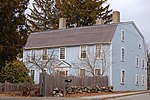St. John's Preparatory School (Massachusetts)
1907 establishments in MassachusettsCatholic Conference (MIAA)Catholic secondary schools in MassachusettsEducational institutions established in 1907Schools sponsored by the Xaverian Brothers ... and 2 more
Use mdy dates from July 2023Vague or ambiguous time from October 2017

St. John's Preparatory School is a grade 6–12 private, Catholic, all-boys college-preparatory school located at 72 Spring Street, Danvers, Massachusetts, United States. It was established in 1907 by the Xaverian Brothers. St. John's was formerly a combination commuter-boarding school but ended its residential program in 1975.
Excerpt from the Wikipedia article St. John's Preparatory School (Massachusetts) (License: CC BY-SA 3.0, Authors, Images).St. John's Preparatory School (Massachusetts)
Spring Street, Danvers
Geographical coordinates (GPS) Address Phone number Website External links Nearby Places Show on map
Geographical coordinates (GPS)
| Latitude | Longitude |
|---|---|
| N 42.5825 ° | E -70.952777777778 ° |
Address
Saint John's Preparatory School
Spring Street 72
01923 Danvers
Massachusetts, United States
Open on Google Maps










